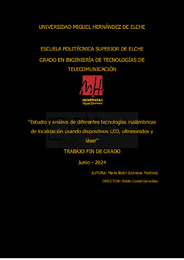Título :
Estudio y análisis de diferentes tecnologías inalámbricas de localización usando dispositivos LED, ultrasonidos y láser |
Autor :
Espinosa Martínez, María Belén |
Tutor:
Corral González, Pablo |
Editor :
Universidad Miguel Hernández de Elche |
Departamento:
Departamentos de la UMH::Ingeniería de Comunicaciones |
Fecha de publicación:
2024-06 |
URI :
https://hdl.handle.net/11000/32696 |
Resumen :
Este Trabajo de Fin de Grado tiene como objetivo analizar diferentes sistemas de localización en tiempo real, mediante estimación de distancias y triangulación, utilizando los algoritmos RSSI (Received Signal Strength Indication), TOA (Time of Arrival) y TOF (Time of Flight) implementados sobre diferentes plataformas. La finalidad es medir y analizar la precisión de la localización de objetos con diferentes algoritmos y tecnologías, ofreciendo una solución práctica y eficaz para aplicaciones en la industria.
El proyecto se ha llevado a cabo en varias etapas, comenzando con el montaje del hardware necesario mediante la integración de sensores de ultrasonido HC-SR04, sensores láser VL6180X y fotodetectores BPW21 y BPW77NB con placas Arduino Uno y Mega 2560. Los fotodetectores han sido fundamentales para la implementación del algoritmo RSSI, proporcionando mediciones precisas de la intensidad de la señal recibida. El sensor de ultrasonidos se ha usado para implementar el algoritmo TOA. Y finalmente, con el sensor láser VL6180X se ha implementado el algoritmo TOF.
Posteriormente, se han implementado y programado los algoritmos de localización (TOA y TOF) en el entorno Arduino IDE, y se han creado scripts en Visual Studio Code específicos para la automatización de la toma de datos y la optimización de las mediciones.
Para la captura y análisis de las señales de los fotodetectores (algoritmo RSSI), se han utilizado herramientas como el osciloscopio digital WaveForms y el Analog Discovery 2. Los datos obtenidos han sido procesados y visualizados con herramientas de software como Visual Studio Code, permitiendo la creación de gráficos y tablas comparativas que han facilitado la evaluación del rendimiento y precisión de cada algoritmo.
El análisis de los resultados ha permitido identificar las ventajas y limitaciones de cada tecnología y algoritmo utilizado, contribuyendo al desarrollo de sistemas de localización en tiempo real más precisos y eficientes.
This Final Degree Project aims to analyze different real-time localization systems, by means of distance estimation and triangulation, using RSSI (Received Signal Strength Indication), TOA (Time of Arrival) and TOF (Time of Flight) algorithms implemented on different platforms. The aim is to measure and analyze the accuracy of object localization with different algorithms and technologies, offering a practical and efficient solution for industrial applications.
The project has been carried out in various stages, begining with the required hardware set up by integrating HC-SR04 ultrasound and VL6180X laser sensors and BPW21 and BPW77NB photodetectors with Arduino Uno and Mega 2560 plaques. The photodetectors have been fundamental for the implementation of the RSSI algorithm, providing accurate measurements of the received signal strength. The ultrasound sensor has been used to implement the TOA algorithm. And finally, the VL6180X laser sensor has been used to implement the TOF algorithm.
Subsequently, the localization algorithms (TOA and TOF) have been implemented and programmed in the Arduino IDE environment, and specific scripts have been created in Visual Studio Code for the automation of data acquisition and optimization of the measurements.
To capture and analyze the signals from the photodetectors (RSSI algorithm), tools such as the WaveForms digital oscilloscope and Analog Discovery 2 have been used. The data obtained were processed and visualized with software tools such as Visual Studio Code, allowing the creation of graphs and comparative tables that facilitated the evaluation of the performance and accuracy of each algorithm.
The analysis of the results has allowed us to identify the advantages and limitations of each technology and algorithm used, contributing to the development of more accurate and efficient real-time localization systems.
|
Palabras clave/Materias:
localización en tiempo real
RSSI
TOA
TOF
Arduino
real-time localization
ultrasound sensors
Discovery 2 |
Área de conocimiento :
CDU: Ciencias aplicadas: Ingeniería. Tecnología |
Tipo de documento :
info:eu-repo/semantics/bachelorThesis |
Derechos de acceso:
info:eu-repo/semantics/openAccess
Attribution-NonCommercial-NoDerivatives 4.0 Internacional |
Aparece en las colecciones:
TFG- Ingeniería de Tecnologías de Telecomunicación
|
 La licencia se describe como: Atribución-NonComercial-NoDerivada 4.0 Internacional.
La licencia se describe como: Atribución-NonComercial-NoDerivada 4.0 Internacional.
.png)
